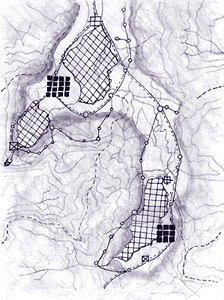Travel Grants» Travel Grant Recipients
|
AKPIA@MIT SUMMER ’98
In the summer of 1998, AKPIA@MIT organized fieldworks in Italy, Morocco and Pakistan, to provide students with on-site instruction in the built landscape, typology and urban morphology. Aga Khan Professor Attilio Petruccioli oversaw the three workshops, coordinating with colleagues from a broad swath of institutions to provide a rigorous and meaningful experience. |
||||
|
 and typological processes. Those who attended were: MIT SMArchS students Nandini Bagchee, Markus ElKatsha, Deeba Haider, Saman Mahmood, Puja Nanda, Nilay Oza, and Luke Young; BSAD candidate David Hamby; MArch students Jacob Kain and Zachary Kron; HTC PhD student Jorge Otero-Pailos; and Harvard GSD student Shundana Yusaf. The workshop was a great success due to the relentless work of students and the great beauty of the local landscape, and many superb dinners cooked by Mrs. Gabriella. and typological processes. Those who attended were: MIT SMArchS students Nandini Bagchee, Markus ElKatsha, Deeba Haider, Saman Mahmood, Puja Nanda, Nilay Oza, and Luke Young; BSAD candidate David Hamby; MArch students Jacob Kain and Zachary Kron; HTC PhD student Jorge Otero-Pailos; and Harvard GSD student Shundana Yusaf. The workshop was a great success due to the relentless work of students and the great beauty of the local landscape, and many superb dinners cooked by Mrs. Gabriella.Image of students drawing in the Tuscan area. |
||||
|
The AKPIA/MIT Morocco fieldwork in Fez consisted of four levels of study intended to cast new light on the positive contributions of minor communities to the built Islamic heritage. The focus of the investigation was Fez Jdid’s Mellah (Jewish quarter) an integral part of the city’s life, largely populated by the Muslim community and which remains an urban fragment with a distinct architectural identity. In order to comprehend the issues that once related and separated the Muslim from the Jewish quarters, students were asked to analyze and carry out typological studies in the form of analytic sketches and measured drawings of selected structures. Students participated in a dialogue with local professionals. The work became more specific when students began measuring and drawing the planimetric urban morphology of the Mellah at a scale of 1:500. This task involved measuring every single building and public thoroughfare at the street level. This documentation was used to analyze the dependence of the built fabric on existing topographies, hydrographic basins, and historical trade routes. Recognizing the value of this documentation the mayor of Fez and local institutions were provided copies. Later work focused on: the domestic architecture of the Mellah, its similarities to the traditional “Arab” house, its formal typology and constructive principles, and environmental solutions to past and present urban fabric. “As built” plans, sections and axonometrics at a scale of 1:25 were executed for more than 12 residences of various scales and patronages. An understanding of the urban/architectural fabric within a socio-historical context was discussed. Students carried out research in local archives and interviewed many residents to better understand the built context. AKPIA work was exhibited at the Dar Batha Museum. The opening was attended by the local professional and intellectual community, Mr. Mohammed Fassi Fehri, Governor of the prefecture of Fez-Medina, Mr. Abderrahim Filali Baba, President of the Communante urbaine of Fez, and various other state officials. Hospitality was enormously pleasurable and intellectually stimulating. Students experienced the famous “trompeta fish” of the host cook Max. The fieldwork was directed by Prof. Attilio Petruccioli and Harvard Prof. Susan Miller, with the collaboration of Prof. Mauro Bertagnin (Universita’ di Udine, Italy) and Prof. Said Mouline of the Moroccan Ministry of Housing. Participating students were: MIT SMArchS candidates Nandini Bagchee, Markus ElKatsha, Deeba Haider, Kim Loddo, Saman Mahmood, Puja Nanda and Nilay Oza; MIT HTC PhD candidate Jorge Otero-Pailos; Harvard students Zachary Hinchliffe and Shundana Yusaf of the GSD and Ilham Khuri-Makdisi and Sahar Bazzaz of the Center for Middle Eastern Studies; and, from the University of Udine, Clelia Mugiguerra. |
||||
|
Within the context of a research of Islamic cities around the world, AKPIA/MIT organized a two-week summer workshop in the historic city of Peshawar, Pakistan, in collaboration with the University of Peshawar and the University of Engineering and Technology (UET), Lahore. Other institutions participating in the field studies were National College of Arts (NCA), Lahore; Dawood College of Engineering and Technology, Karachi; and School of Architecture, Ferrara, Italy. The workshop was held under the leadership of Prof. Attilio Petruccioli. Participating faculty members were MIT Research Associate Shakeel Hossain, Visiting Harvard Fulbright Scholar Abdul Rehman, and UET Professor Yousaf Awan. In total, four students from MIT, five from Ferrara, 12 from NCA, 10 from UET, and five from Dawood participated in the workshop. Markus ElKatsha, Jacob Kain, Zachary Kron, and Luke Young participated from MIT. Students spent their first few days in Pakistan in Lahore, where they were briefed on previous research projects conducted by the Pakistani colleges and studied the Pakistan Environmental Planning and Architectural Consultants’ conservation plan for Lahore’s walled city. En route to Peshawar students had the opportunity to view Islamabad. In late July students arrived in Peshawar and began conducting field studies, which consisted of two stages. First, the participants documented and studied the housing typology of nine houses, which were carefully selected to represent various strata of the society and different locations with reference to land uses. Second, the students documented three different sections of the urban fabric of the walled city. Students conducted fieldwork throughout the day, attended lectures in the latter part of the day and followed with studio work in the evenings. |
||||
|
 |



